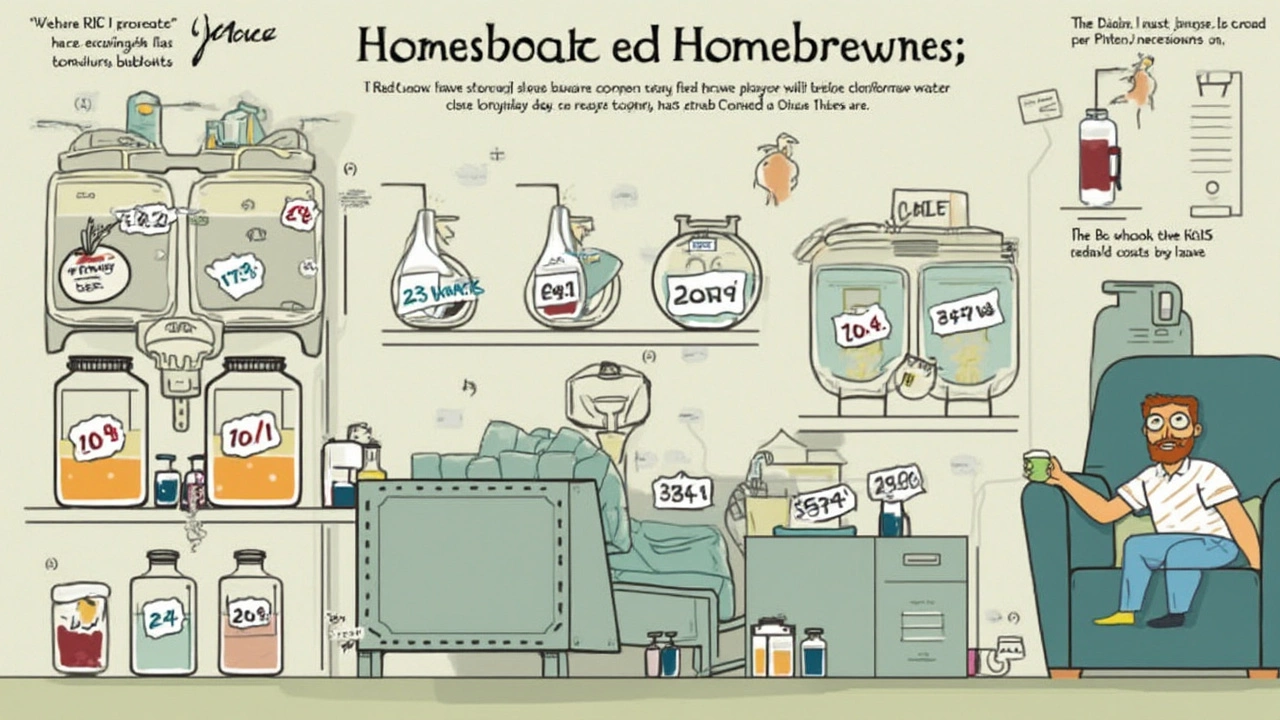Curious how much money you'll actually spend making your own beer at home? You’re not alone—every homebrew hobbyist hits this question. After all, part of the fun is bragging about how cheap your DIY pints are.
The truth: homebrew can be very affordable per pint, but it comes down to what you brew, which kit you use, and whether you go basic or fancy with ingredients. You’ve got to look at more than just the ingredient pack or the cost of a shiny new kit—think bottles, cleaning supplies, maybe some broken batches, and your water and energy costs too.
Getting a grip on the real math keeps things honest. Some folks end up paying less than a dollar per pint after the first few batches, but if you get carried away with rare hops and boutique yeasts, your price goes up fast. It’s not all just about saving cash—a lot of the value is in the process and the fun.
- What Shapes the Cost per Pint?
- Starter Kits: Initial Investment
- Ingredient Costs Explained
- Are Homebrews Really Cheaper Than Store-Bought?
- How to Shrink Your Per Pint Cost
- Is It Worth the Effort for You?
What Shapes the Cost per Pint?
So, what actually goes into the homebrew cost for each pint you make? It’s not just the kit or the grain—there are a bunch of things to factor in, no matter how simple or wild you want to go.
First up, the price of a pint depends on how much you invest upfront. A basic starter kit might run you $50 to $100, and that’s just to get rolling. After that, each batch will need more ingredients—and they're not all priced the same. Malt extract, grains, hops, yeast, and even special water treatments can add up. Then there’s stuff like bottles, caps, cleaning powder, and sanitizer.
And you can't forget the "hidden" stuff: your energy for boiling water, the water itself, and any lost beer due to spills or failed batches. Most brewers also end up getting little upgrades over time—like a better thermometer, fancy carboys, or reusable bottles—which all tip the scales.
- Kit type: Entry kits are the cheapest, but advanced gear can double or triple your start-up costs.
- Batch size: Bigger batches spread out the initial investment, but use more ingredients.
- Ingredient choices: Cheap extract kits might cost $20 per batch, but premium hops and organic grains hike up the price.
- Consumables: Bottles, caps, and cleaning supplies are recurring costs.
- Utilities: A couple bucks for water, maybe $1–$2 in electricity or gas per batch.
- Lost beer: Plan for around 10% loss to spills, sediment, or just tasting along the way.
Check out this breakdown for a 5-gallon (about 40 pints) batch using a standard kit:
| Expense | Typical Cost |
|---|---|
| Starter kit (spread over 10 batches) | $8 |
| Ingredients (per batch) | $25 |
| Bottles/Caps | $4 |
| Sanitizer & Cleaning | $2 |
| Utilities | $2 |
| Total (per 40 pints) | $41 |
This math gets you right around $1.03 per pint—not counting time and labor, because that’s part of the fun for most folks. If you reuse bottles and keep your gear, the price can dip even lower over time.
Starter Kits: Initial Investment
Let’s talk about what it really costs to get started with homebrew. The first thing you’re buying is a home brewing starter kit. Don’t worry, you don’t need to build a brewery in your garage. Most kits are designed for beginners and come with everything you need for your first batch: a fermenter, airlock, bottles, sanitizer, and sometimes even an ingredient mix.
The price range is pretty wide, depending on what’s included and how big a batch you want to brew. Most entry-level kits run from $40 to $80 in the US. These usually produce about five gallons (or a little under 50 pints) per batch. More advanced setups with glass carboys, more gadgets, or bigger batch sizes can go north of $150, but you don’t need to start there.
Here’s a quick comparison of what you might spend:
| Kit Type | Cost (USD) | Batch Size (Gallons) | Pints per Batch |
|---|---|---|---|
| Basic Starter Kit | $50 | 5 | ~45 |
| Mid-Range Kit | $90 | 5 | ~45 |
| Deluxe Kit | $160 | 5 | ~45 |
If you want to cut costs, look for deals that bundle in bottles and cleaning gear. If you already have large kitchen pots or extra bottles, you can skip kits that include those and save a few bucks. Remember, this is a one-time investment—once you’ve got your kit, you’ll only be buying ingredients and replacing cheap parts like bottle caps and sanitizer from batch to batch.
One quick tip: don’t get sucked into expensive upgrades too quickly. Start simple, see if you like the hobby, then add fancier stuff if you really stick with it. Your per pint price drops fast as you brew more batches and use the kit again. That’s where the real savings show up.
Ingredient Costs Explained
If you want to know what really drives your homebrew cost per pint, look at your ingredients. Most home brewers use four basics: malt (or malt extract), hops, yeast, and water. These aren’t just basics in recipes—they’re where your money goes, batch after batch.
Malt or malt extract is usually the priciest ingredient. If you use liquid malt extract (LME), you’ll probably spend about $10-$15 for a 5-gallon batch. Switching to all-grain can be cheaper per batch, but you’ll use more equipment and work. For most kits, the malt runs about $1-1.50 per pint.
Hops prices will vary a lot depending on the style and brand you buy. For a typical pale ale, you might spend $2-$4 on hops. Go nuts on an IPA and you can double that or more. If you’re chasing wild flavors or new hop varieties, get ready for a bigger bill.
Yeast usually runs $2-$5 per batch for standard dry sachets. Liquid yeast can cost more, but you can split it across batches if you plan ahead. Water is usually super cheap unless you go for bottled or filtered, in which case a 5-gallon batch might cost you around a buck.
Here’s a quick table showing typical ingredient costs for a 5-gallon batch:
| Ingredient | Average Cost (5 Gallons) |
|---|---|
| Malt or Extract | $10–$15 |
| Hops | $2–$8 |
| Yeast | $2–$7 |
| Water | $0–$1 |
| Total | $14–$31 |
For most home brewers, that 5-gallon batch gives you roughly 40 to 50 pints. That means, ignoring equipment, you’re looking at $0.30–$0.80 per pint just for ingredients. If you’re brewing something big and boozy or packed with hops, expect to be at the higher end or even above.
Two easy ways to cut ingredient costs: buy in bulk (especially grain and hops) or split ingredient packs with a buddy. Some homebrew shops let you buy exactly what you need, by the ounce or pound, which helps if you’re just testing recipes.

Are Homebrews Really Cheaper Than Store-Bought?
This is the real burning question for folks thinking about giving homebrew a go: does your homemade beer actually save you money per pint compared to what you'd grab off the shelf? The answer: usually yes, but there are some catches and it depends how you brew.
If you stick with a basic home brewing kit and standard recipe ingredients, you’re looking at somewhere between $0.60–$1.00 per pint, not counting your first-time gear purchase. Compare that to buying decent craft beer at the store, which typically runs $2–$4 per pint (and even more at the pub). So, just by looking at the math, homebrew can be a lot cheaper per glass.
| Beer Type | Average Cost Per Pint |
|---|---|
| Homebrew (basic kit) | $0.80 |
| Craft Beer (store-bought) | $2.50 |
| Pub Pint | $6.00 |
But here’s the kicker: your actual savings show up after you brew a few batches and the upfront gear cost evens out. If you splurge on top-quality ingredients, experiment with weird styles, or buy extra gadgets, your pint price goes up. Those first 20 to 40 pints will seem pricier because you’re still recouping your brewing kit cost.
What really eats into savings is the extras nobody thinks about: water, electricity for boiling, sanitizer, and maybe lost batches if things go sideways. Over time, though, most homebrewers say their average pint lands way below what they’d pay at a liquor store for a similar DIY beer—especially if they brew in bigger batches.
- Brewing larger batches lowers your cost per pint.
- Bottles and caps are almost nothing if you clean and reuse them.
- Avoiding fancy recipes keeps the bill low.
If you just want cheap, reliable beer and don’t crave rare styles, homebrew wins hands down on price. Add in the fun factor and bragging rights, and it's a solid deal.
How to Shrink Your Per Pint Cost
So, how do you make your homebrew cost per pint drop as low as possible? It comes down to getting smart about where you put your money and reusing what you can.
First, buying ingredients in bulk is a game-changer. Grains, malt extract, and hops are all cheaper per pound or ounce when you buy the bigger bag. Join a local homebrew club—members often pool orders to score discounts.
Another no-brainer is to reuse your equipment and bottles. Once you’ve got a sturdy fermenter, decent auto-siphon, and bottles (ask friends to save theirs!), you won’t need to shell out for new ones each batch. Don’t underestimate how much you save by just washing and reusing instead of rebuying.
- Buy ingredient kits during sales or at the end of brewing season when shops clear old stock.
- Stick to simpler beer styles. Basic ales and lagers usually need fewer and cheaper ingredients.
- Try dry yeast—it’s usually half the price of liquid yeast packets, plus it keeps longer.
- Simplify your process. Skip fancy additives unless you know they’ll really up your beer’s quality.
Here’s a quick example of what happens to per pint price by reusing your stuff and watching ingredient costs:
| Item | New Purchase | Reused |
|---|---|---|
| Basic Homebrew Kit (per batch) | $40.00 | $0.00 |
| Ingredients (5 gallons) | $30.00 | $30.00 |
| Bottles | $12.00 | $0.00 |
| Total (per 40 pints) | $82.00 | $30.00 |
| Cost Per Pint | $2.05 | $0.75 |
This table shows it plain as day. The first batch is pricier, but if you keep brewing with the same gear, your homebrew cost per pint plummets. That’s when homebrewing really starts to pay off. The more you brew, the cheaper each pint gets—even if you keep it simple and fun.
Is It Worth the Effort for You?
This is where it really gets personal: is making homebrew actually worth your time and money? The answer depends on what you want out of it. If you’re just after the cheapest pint, you can get homebrew cost down pretty low. Regular kits crank out pints for as little as 60 to 90 cents if you reuse bottles and avoid premium ingredients. But what about your time, patience, and all those little extras?
Homebrewing takes effort. You’ve got to set aside time for cleaning, sterilizing, brewing, transferring, bottling, and waiting—sometimes a few hours per batch, with a couple weeks of patience before you get to take that first drink. A study by the American Homebrewers Association in 2022 found the average homebrewer spends about 6 to 8 hours per five-gallon batch, counting everything from prep to cleanup. That’s about two cases of beer.
If you love the DIY side, you’ll probably enjoy the process as much as the finished beer. Here’s what to keep in mind if you’re still on the fence:
- If your goal is pure savings, stick to basic ingredients and reuse your gear. Skip fancy kits that promise "triple IPA magic" for five times the price.
- For total beer geeks, homebrewing is a ticket to experiment: want to try a jalapeño porter or tinker with Belgian yeasts? Go wild—the homebrew scene is famous for wild recipes and custom tweaks.
- If you’re after convenience, don’t expect homebrew to beat the quick run to the store. Making beer takes time and patience.
- Got friends to share a batch? Brewing together can turn a hobby into an event—plus, you can swap tips and split ingredient costs.
Here’s a quick look at how the real homebrew cost per pint stacks up with store-bought craft beer in 2025:
| Beer Type | Average Cost per Pint (Homebrew) | Average Cost per Pint (Store-Bought Craft) |
|---|---|---|
| Basic Pale Ale | $0.70 | $3.50 |
| IPA (with premium hops) | $1.20 | $4.50 |
| Simple Lager | $0.65 | $3.20 |
Like one long-time homebrewer said,
“You can buy a six-pack anytime, but you can’t buy the pride in making something great yourself.”
If saving money is your top priority, homebrew cost per pint is tough to beat—even with a bit of effort. But the real win is banging out a batch with your own hands and calling it yours.


